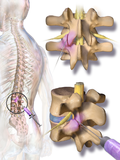Facet joint: Difference between revisions
CSV import Tags: mobile edit mobile web edit |
CSV import |
||
| Line 27: | Line 27: | ||
{{stub}} | {{stub}} | ||
== Facet joint == | |||
<gallery> | |||
File:Facet_Joints.png|Diagram of facet joints | |||
File:Blausen_0391_FacetJointInjection.png|Illustration of a facet joint injection | |||
File:APEndonucleasecartoon.gif|Animation of an AP endonuclease | |||
</gallery> | |||
Latest revision as of 00:57, 18 February 2025
Facet Joint
The facet joint or zygapophysial joint is a set of synovial, plane joints between the articular processes of two adjacent vertebrae. There are two facet joints in each spinal motion segment. The function of the facet joint is to guide and limit movement of the spinal motion segment.
Etymology[edit]
The term "facet" comes from the French "facette" (little face), and the term "zygapophysial" comes from the Greek "zygon" (yoke) and "physis" (process).
Anatomy[edit]
The facet joints are formed by the superior and inferior articular processes of each vertebra. The superior articular process faces upward and the inferior articular process faces downward. The joint is surrounded by a joint capsule and is filled with synovial fluid.
Function[edit]
The facet joints work together with the intervertebral discs to support the spine and allow for movement. They also prevent excessive movement such as hyperextension or hyperflexion.
Clinical significance[edit]
Facet joint syndrome, also known as osteoarthritis of the spine, is a common cause of back pain. It is caused by degeneration of the facet joints, which can result in inflammation, swelling, and pain. Treatment options include physical therapy, medication, and in some cases, surgery.




